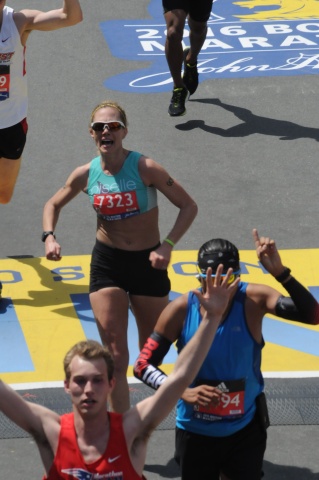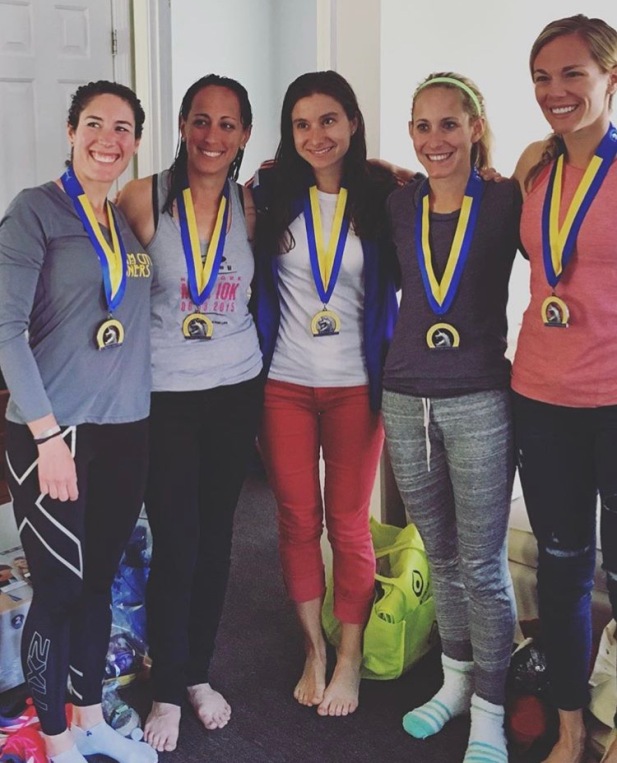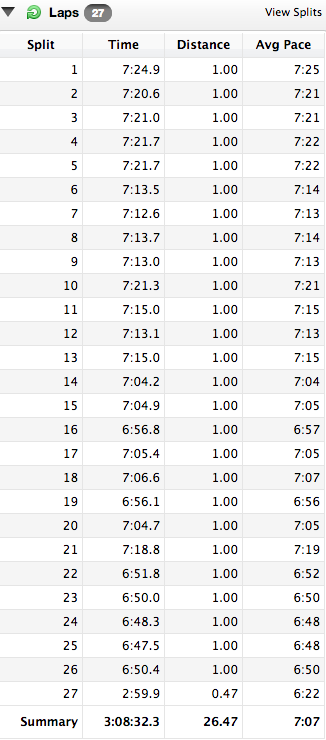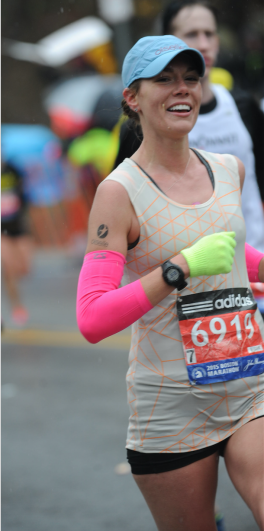There’s so much more to the Boston Marathon (or ANY marathon, for that matter) than just a solid pacing strategy. This post attempts to cover the other pre-marathon stuff that falls in the “miscellaneous…but extremely important” category.
If you missed Part 1 (pacing tips & strategies), I recommend you backtrack and read it HERE.
—
Tip #1a: Be cognizant of the weather
This thought came to me after publishing the last post, and it’s pretty important.
The weather is supposed to be pretty mild on Monday. Right now, it’s looking to be in the mid-50s with a friendly NW wind to push you into Beantown. For most runners (myself included), this is actually an awesome forecast. But regardless of what’s forecasted: I urge you to be realistic with what works for YOU. Consider your race plan and goal finish time wisely, and take the heat into consideration.
Last year, it was hot as balls…but no one knew just hot how it actually was going to be until we were in Hopkinton, with the sun BEAMING down over our heads. I remember sweating just standing, waiting to start, listening to the national anthem being sung. Even though I was hot, I stood in my corral, convinced I was still going to break 3.
Fast forward 7 miles into the race, a runner next to me chuckled, “ha, this isn’t the day to PR! Today is about survival.” I was pissed, and I surged away from him muttering, “that’s what you think.”
It wasn’t until mile 14 that I realized I needed to reconsider things. So I changed my race plan, and I finished the remaining miles with an updated goal in mind. I was one of the lucky few to PR.
What I WISH I had done was been a little more realistic, and changed my goal time while I was standing in Hopkinton. I would’ve gone out much slower, and I probably wouldn’t have positive split the race by 4 minutes.
Hindsight is 20/20, I know. But know that if you’re warm at the start of the race…you’re only going to get hotter…and you might want to reconsider your pacing strategy. Avoid a death march before it starts!
Tip #2: Keep off the breaks
Yes, there is a way to attack the downhills, and yes, you should think about it while you’re running the Boston Marathon.
I compared my body to a car in the first post: I like to consider myself driving in neutral for the first 4 miles; and one of the most important things to think about in this section is keeping off the breaks.
What do I mean? Be kind to your legs as they cruise downhill. Obviously your cadence is going to quicken on a decline (that’s only natural). But another natural tendency–especially if you’re trying to hold back and not go out like a bat out of hell–is leaning back and tensing up in an attempt to slow down.
You don’t want to do that.
Instead, focus on running the hills strategically, and with good form:
- Lean FORWARD slightly (not back)
- Hit the ground with your mid-foot
- Do your best attempt to keep your feet underneath your hips
- Keep your neck relaxed
Or keep it simple and just imagine yourself gliding (prancing?) down the hills in a neutral gear.
Tip #3: Training doesn’t have to be perfect to have a perfect race
Three words: TRUST. YOUR. TRAINING.
More words: EVEN. IF. IT’S. NOT. PERFECT.
The odds of having an absolutely perfect training cycle are slim to none. Everyone takes personal days. Everyone gets a cold. Everyone needs to take extra days off to rest a little niggle. Everyone has to deal with LIFE, even professional runners.
Needing to take a string of days completely off–even weeks off–from running does not mean you’re going to have a terrible race. Depending on the reason for the time off, you may have to adjust your goal time. When in doubt: be rational, realistic, and conservative. But also trust that even though you took March 3rd through 6th off for that tender ankle tendon, it doesn’t mean you can’t PR.
Training is cumulative (which is why I hate hype on things like “ZOMG PEAK WEEK”) and it also takes a pretty long time to get “out of shape” when you decrease your aerobic activity. Even if you need to skip multiple days; what’s important is the work you’ve put in over the course of your ENTIRE training cycle.
Also, when we held our live chat last week, one of our coaches, Tim Ritchie, brought up a very valid point: don’t hang your shoes on a single workout–good or bad. When you’re thinking about your goal time, you must consider the big picture of all your runs and workouts. Just because you had one lights-out workout might not mean you’re ready to run an OTQ. And just because you bonked your last effort at marathon pace does not mean you’re doomed. Calm down and be realistic.

Remember the good runs, but don’t hang onto them for dear life
Tip #4: Read the material from the BAA. Know where you’re going in the morning. Be on time. Know where the bag drop-off is. Know where the buses are.
I’m not here to tell you where you’re going the morning of the 17th, but I AM here to tell you to get your shit together and make sure you have it all figured out before you wake up marathon morning.
Unfortunately, last year, I did not have my shit together and I ended up making an extra lap around the Commons and down the street trying to find the bag check (which they had moved to Boylston St.). When all was said and done, I was fine and I didn’t miss my bus…but it did cause some unnecessary stress and walking, which I could have avoided had I just read the material from the BAA.
Tip #5: Figure out what you are and aren’t taking on the bus to Hopkinton.
Everything you bring on the bus either comes along with you as you run the marathon…or you throw it out.
There’s something wonderful and so exhilarating about dropping your stuff at the bag check and just knowing that that’s it. Typically, I only bring nutrition, fluids, and an inhaler (which I’m prepared to throw out) to Hopkinton.
Don’t forget to make a trip to Goodwill before the marathon to get warm clothes to go over your marathon outfit. Boston’s weather is crazy, so you never know how many layers you’ll need. Also – bring something to sit in at Athlete’s Village! Year after year I forget to do that, and I regret it.
Tip #6: Spend some time thinking about nutrition.
I’m not a nutritionist, but I think I have a pretty good handle on nutrition. While nutrition could be a post of it’s own, I’ll keep this succinct. I’m going to cover my thoughts about race nutrition as well as nutrition the morning of the marathon, which needs to be thoughtfully planned as well.
Race Nutrition
By now, you should have a pretty good idea of not only the type of nutrition you prefer while running, but also how frequently your body likes eating it.
The hotter and/or more effort you’re putting out, the more nutrition you’re going to need to take in. Which means if you’re negative splitting the race and you’re running significantly faster in your back-half, you’re going to need to ingest more calories per mile than you did in the first half. This isn’t rocket science. Food is fuel, especially when you’re running a marathon. And when things start to speed up, you NEED to compensate by taking in more calories.
Generally, I will eat 1 gel 15 minutes before the start, then start nutrition during the race at mile 4. I keep eating gel (Huma) every 30-40 minutes, washing down with water. Through the entire course of a marathon, I will go through 5-6 gels. I used to think that was too much until I started seeing a positive increase in energy levels. Obviously the number of gels you need will change depending on how long it takes you to run a marathon! The longer you’re running, the more fuel you’ll need. Remember: my plan works for me because I run around a 3:0x marathon.
When it comes to fluids, I suggest switching back and forth between water and gatorade along the course, as you feel fit. The course support is incredible at Boston, and I’ve never had difficulty getting a cup of SOMETHING while running.
Also families and supporters will be out in HERDS along the course, offering water bottles, orange slices, wet cloths, and vaseline. If you miss a water cup at a stop, don’t fret: there likely will be an opportunity to grab something else down the road. (And I’m telling you…there’s something magical about eating an orange slice in the middle of a marathon.)
Race Morning Nutrition
Your nutrition on race morning depends on the time of your wave. The later your start is, the more you’ll likely need to eat in the morning. And it’s a long morning.
 DO eat what you normally would before a long run
DO eat what you normally would before a long run- DO bring food (or a second breakfast of sorts) with you to Hopkinton
- DO bring water/electrolytes with you to Hopkinton
This is what I’ve eaten prior to my 3 Bostons:
Breakfast 1 (upon waking up)
- Mini bagel w/ a generous amount of peanut butter
- Coffee & water
- Banana
Breakfast 2 (bus to Hopkinton)
- 2nd mini bagel w/ peanut butter
- 2 scoops of Generation UCAN
- Gatorade & water
Breakfast 3 (Hopkinton)
- Picky Bar (or non-processed bar of sorts)
- Gatorade & water
- Gel (15 minutes prior to starting)
Remember: don’t try anything new on race day. By now, you should have a solid idea of what works and what doesn’t work for you.
Tip #7: Temper your race week nutrition too
When it comes to food leading up to the race, I recommend not changing much, but slightly incorporating a few more carb-y selections into your diet. No, I don’t mean eat pasta Monday through Saturday. I mean reaching for two dinner rolls instead of one…or having a regular-sized bagel instead of a mini bagel. Keep your fats down and I also start backing away from salads and tons of fiber 1-2 days prior to the race. Hydrate hydrate hydrate. Know that IT’S OK to feel bloated and as though you’ve gained weight. It doesn’t mean you’re heavy and/or out of shape.
The day before a marathon, I eat a decent-sized lunch (usually carb-heavy) and then a regular dinner (usually chicken and an average serving of carbs). Resist the urge to stuff yourself silly during dinnertime. Seriously.
Tip #8: Keep stress levels down
While it’s now humorous to tell the marathon story from Philly (which included shitting in the street), it wasn’t very funny while it was happening. I mentioned in my race recap that I had been having GI issues for several weeks leading up to the marathon. What I failed to mention is that my stress levels were also CRAZY HIGH the week of the marathon, particularly the days leading up to the race. I’m also pretty sure I just needed a break from running and training (helloooo racing 3 marathons in a year), so my body decided to rebel in the form of explosive bowel movements. While GI problems are hereditary in my family, after a healthy colonoscopy reading that was performed a month after Philly, I can only conclude that my issues before/during Philly were a product of stress and the fact that my body wanted to shut down after 18 months of consistent training. We live and learn, right?
Moral of the story: keep as calm as possible the days leading up to the race. I’m not saying you’re going to shit all over the train tracks in Natick if you aren’t. Some stress is actually productive. But control what you can and don’t sweat the small stuff.
Tip #9: GO TO SLEEP
Just accept it now: you’re going to get very little sleep the night before the race. But it’s ok. The body works on two-day cycles, so the sleep you get on Sunday night won’t make or break you, I promise. (Ever wonder why you’re most sore two days after lifting instead of the day immediately following? Yeah. That concept applies here too.)
I’m a huge fan of Sleep Night–the sacred evening two days leading up to a big race/workout where you sleep as much as humanly possible. And, of course, do your best to sleep the entire week leading up to the race. Like most things associated with training: sleep is cumulative and ample sleep has a positive relationship with performance. So small tweaks in your weekly bedtime routine this week will benefit you come Monday.
Tip #10: Enjoy the city of Boston…but sit the eff down because you’re still running a marathon
Time on your feet is significant. I know you’re excited and IT’S THE BOSTON MARATHON. But if you really want to kill it on Monday, your priority list should be the following:
- Arrive in Boston
- Pick up your bib
- [Briefly] explore the expo
- Do your shakeout run
- Eat. Sleep. Poop. Watch TV. Read a book. (Even have sex…it’s suggested to potentially help with performance!)
- Sit down
It’s supposed to be a beautiful weekend in Boston, but do your best to minimize the amount of time you’re strolling around the city. The less moving around you’re doing, the better.
—
When all is said and done: have fun. You’re running the Boston fucking Marathon. Enjoy the anticipation of this entire week. Get excited to spend time with friends you haven’t seen in a while. Drink a glass of wine with the extra time on your hands during taper. Say a special prayer to commemorate those who lost their lives and limbs in the 2013 bombing. Look out the window on the bus ride to Hopkinton and feel the excited butterflies in your stomach. Give ALL the high-fives. Hug a stranger when you cross the finish line. Let yourself be emotional. Soak in everything that the Boston Marathon has to give, because it is a privilege and an honor to not only cross the starting line, but to simply be a part of this incredible weekend.

Most importantly: hug your friends. Be proud of what you’ve all accomplished.



